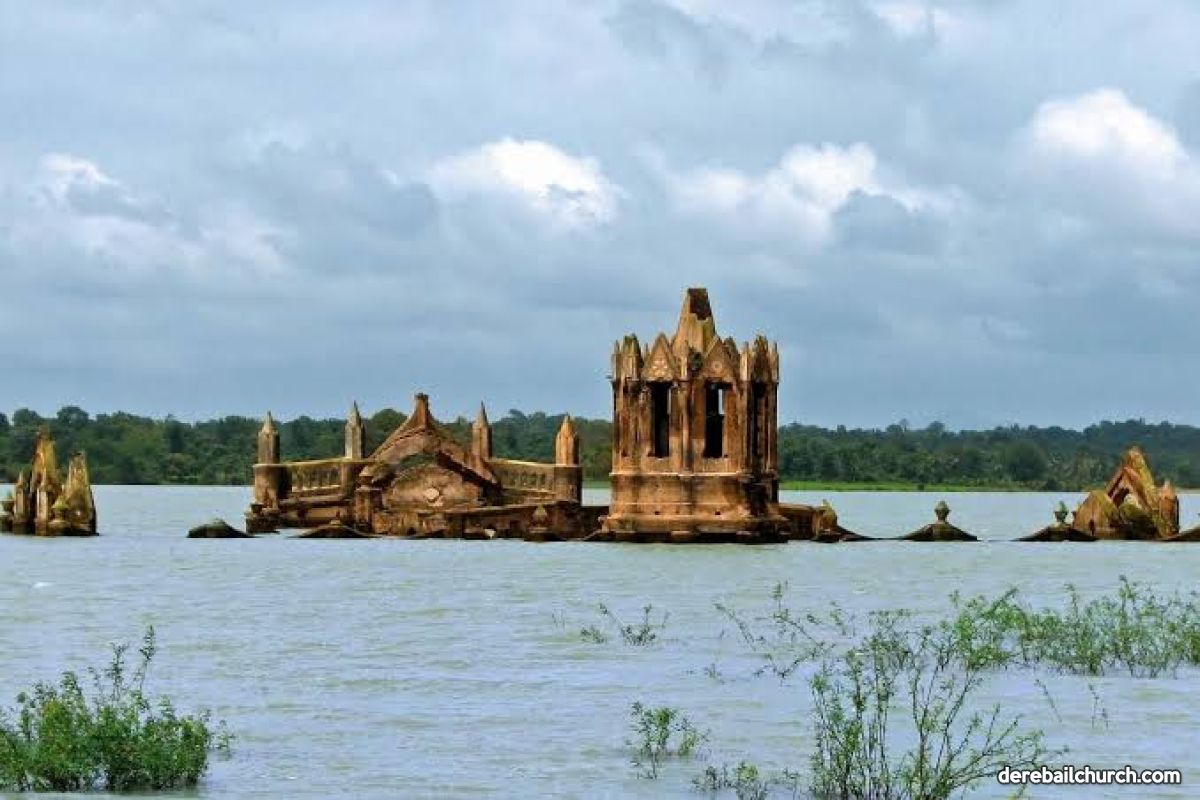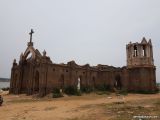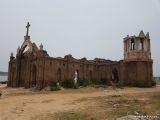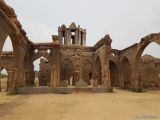The Submerged Church and Its Floating History: Shettihalli Back
The Submerged Church and Its Floating History: Shettihalli
|
“No church bells ring here, no stained glass windows decorate the interior; Sunlight floods in from the top into this roofless ruin, and come monsoon, waves splash against the moss covered walls of its structure. Its location remains undiscovered on Google maps, and is accessible only to those willing to take the isolated dirt track that leads to this oft-overlooked site. But there is a beauty in its dilapidation that makes this 19th century monument worth…”. - Ria Gupta |
A recently published research paper by the Centre for Study of Science, Technology and Policy, Bengaluru, stirred widespread debate in Mangaluru and Udupi. The study drew attention of the general public, as it predicts that with the rising sea levels, five percent of land in these Western Coastal cities could be submerged by 2040.
As I began to ponder where I might be in 2040 and what would happen if Mangaluru actually got submerged, my thoughts were abruptly diverted to memories of a church that I visited in 2021. But why did this church come to my mind? Great thinkers like Aristotle and Daniel Schacter discuss how the present can trigger memories of the past. Truly, the thought of our cities being underwater reminded me of this church, which gets submerged every rainy season.
The Shettihalli Rosary Church in Shettihalli village, Hassan district, with its gothic structure- a symbol of its resilience against seasonal submersion- leaves a lasting impact on anyone who visits at least once in their lifetime. But, this church ought to be visited twice a year. One in the summers, when you can easily walk through its unguarded doors and feel the essence of its rich history; and again, during the monsoon, when the waters from the Hemavathi River submerge its very existence.
After enduring the pandemic, a visit to this church felt like a much-needed respite from being confined to our home. My husband and I, who were holidaying in Kushalnagar, drove to Shettihalli Rosary Church in April, 2021. The drive to this village, through the worn and torn, deserted roads made me wonder, “Where are the villagers? Why is no one around?” I began to ponder whether future visitors to Mangaluru too might have similar thoughts about us. No one knows. But one thing is certain: history often enhances and deepens our understanding of the present. The present becomes a site of interrogation and the past seems to answer these questions. I, thus, began to look into the history i.e., the past of this church.
During the colonial era, Hassan was one among the districts where the British established coffee plantations, many of which still exist today. Shettihalli was first recorded in the Jesuit records by the missionary priest, Father Manuel De Almeyda, in 1727 CE. It is believed that there was an older church in Shettihalli that was likely destroyed. However, the new The Holy Rosary Church of Shettihalli, referred to as ‘Sathalli’ was Constructed by French missionaries in 1860 for wealthy British estate owners. This church had a few villages in its vicinity. Fr. Abbe J A Duboi, a French missionary and architect, is credited to be the brain behind the making of this church in 1810.
It is believed that Duboi visited India to work with a Roman Catholic missionary organization. While Duboi was first attached to the Pondicherry mission, he was invited to Srirangapatnam in 1799 CE. It's fascinating to learn that he lived among the locals, adopting their lifestyle, dress, and customs. He is recognized for his efforts in reconverting Christians who had been forced to convert to Islam by Tippu Sultan. The church was, therefore, built to serve both the British rulers and the ruled local people. The church was built in the Gothic style, popular in Europe at the time, to embody the grandeur and majesty of Christian religious structures. Materials like ordinary brick and mortar, along with glass from Belgium, Egyptian gypsum, jaggery and eggshells were utilized in its construction. Could this be the secret behind its remarkable strength against the test of time? Probably.
The church was, thus, set to serve the Christian community in Karnataka, in areas around Hassan, including Changravalli, Shettihalli, Dhoddakoppalu, Gadekopplu, and Madanakopplu. The popularity of the church resides in the yeoman service that it rendered to the poor and needy, irrespective of their religious backgrounds. However, the villagers had to uproot themselves when the proposal for Gorur-Hemavathi dam was approved and eventually constructed in 1960. As the water level rose, the scenic village got inundated, three Hindu temples were also lost. In 1982, the church’s roof collapsed. The relocation of the villagers, thus, was a welcome move.
Thus, the intersection between nature’s course and human engineering led 28 villages to abandon the church, their homes and lands respectively. The only remnant of Shettihalli is the church, which now exists in two distinct forms. It alternates between standing as a tall, abandoned structure during summers, and becoming a half- submerged entity during the monsoons.
After enjoying the scenery around the church, I decided to walk inside. As I mentioned earlier, memories often resurface in the present, both voluntarily or otherwise. I was reminded of how, during my childhood, my mother would ask me to make three wishes whenever I visited a church for the first time, promising that my prayers would be answered. Kneeling down wasn’t an option, as the church’s entire floor had disappeared, replaced by soil. So, I stood and joined my hands and bowed my head in prayer, only to be pushed aside by a man who was absorbed in photographing his family. To my surprise, his whole family was standing on what little remained of the altar. This is the unfortunate reality of heritage sites today. Film makers find the surreal backdrop of the Shettihalli church irresistible. While some see them merely as opportunities to click photos during vacations, others cherish them as treasures to be preserved and valued.
On a positive note, the Rosary Church, is now a site favoured by historians. Its story of resilience against time and its transformation has found its expression in the thoughts of various writers. However, the information available on the church’s history is very negligible.
It is said that helicopters were deployed to shift statues from certain inaccessible points of the church, during the floods. While I doubt the credibility of this story, I wonder whether the theory of the ‘Ship of Theseus’ is applicable to Shettihalli church. The ‘Ship of Theseus’ is a philosophical paradox, which debates whether a ship, after having all of its parts replaced, remains the same ship, or has it become something different. In the context of the Shettihalli Church, if its parts were moved to a new location: Is it still the same church, or does the new relocated church become Shettihalli church. The answer, as with the Ship of Theseus, depends on how we define the essence of the church—whether it's in its physical materials, its location, or the combination of both.
To me, this church symbolizes the meeting point of two distinct cultures. On the one hand, it reflects the cultural and religious heritage brought by European missionaries to India and on the other, it holds within it the Indian resilience to face oddities bravely. This intersection and blend of cultures as reflected in the church’s structure and essence, makes it a compelling site to explore.
Although Mangaluru and Shettihalli are geographically separated, they both reflect different aspects of Karnataka’s rich history and culture. Mangaluru represents the vibrant, cool, and cosmopolitan side of the state, Shettihalli offers a glimpse into the more rustic and historic past, highlighted by the iconic Rosary church. The commonality between these places is the concern about the future. No one can predict of what will become of Mangaluru and Udupi in 2040. What matters is the present, which should be dedicated to the exploration of these two places.
While we often focus on visiting places renowned for their architectural brilliance, I believe its even more crucial to visit sites that may soon disappear. Shettihalli and its Rosary Church, that stand resilient against challenges, are prime examples. Although I’m unsure if the church can be restored, it is certainly worth visiting, exploring, and appreciating the experiences it offers.
Someone once rightly said, "You don't know what you've got till it's gone." This sentiment rings true for any place. Therefore, it is crucial for us to actively preserve our hometown and draw lessons from historical and cultural sites like Shettihalli. By doing so, we not only safeguard our heritage but also ensure that future generations can appreciate and learn from the treasures we cherish today.
To appreciate the present, one must experience the past. Shettihalli’s Rosary Church provides this by merging history with the present, memory with reality, and offers a view into a bygone era—a submerged church with a floating history.
By Lynsha Lobo











